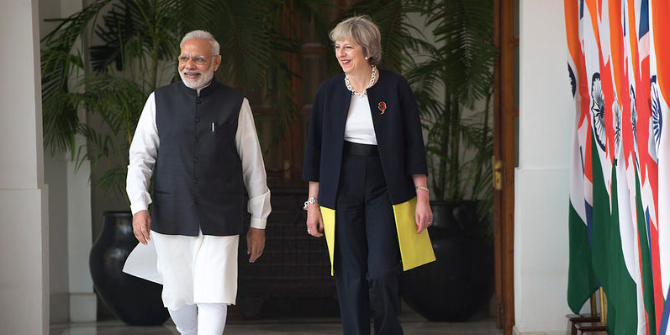 Economist and writer Surjit S. Bhalla’s latest book The New Wealth of Nations investigates what’s behind the huge drop in income inequality and absolute poverty over the last forty years around the world. And at a time when the MeToo Movement grows in strength, he tells Rebecca Bowers how his book helps explain how women and the middle classes continue to hold the keys to change in India.
Economist and writer Surjit S. Bhalla’s latest book The New Wealth of Nations investigates what’s behind the huge drop in income inequality and absolute poverty over the last forty years around the world. And at a time when the MeToo Movement grows in strength, he tells Rebecca Bowers how his book helps explain how women and the middle classes continue to hold the keys to change in India.
Can you explain why you believe that education is the key to increasing income and decreasing inequality in India?
Since 1960, when Gary Becker first discovered this relationship, or articulated this relationship between education, income and inequality, it has been taken as self-evident and true. It is interesting that in the past the economics profession did not think that education contributed much to income. It was only in 1960 that this appeared to be the case, and I discuss that in my book at some level.
 Now if you assume that education leads to a higher level of income then to derive implications about inequality change, all you’ve got to do is to look at the mean education levels in developing countries and how they have changed over the course of the last thirty years. Developing countries, circa 1980, had about a third of the average educational attainment levels of those obtained in advanced economies. Now, such education attainment levels are fast approaching equality with the advanced economies, as the lower income bracket get more and more educated, their income levels rise.
Now if you assume that education leads to a higher level of income then to derive implications about inequality change, all you’ve got to do is to look at the mean education levels in developing countries and how they have changed over the course of the last thirty years. Developing countries, circa 1980, had about a third of the average educational attainment levels of those obtained in advanced economies. Now, such education attainment levels are fast approaching equality with the advanced economies, as the lower income bracket get more and more educated, their income levels rise.
One very easy way to understand as how education leads to lower income inequality is by the example of India and the Kuznets curve, which was the hypothesis that as countries develop, inequality would go up (because of movement from low productive agriculture to higher productivity manufacturing), and then only after they had reached an advanced stage, would inequality begin to go down.
However, in India, since 1983, real consumption inequality, which is the only data we have, has stayed constant. An explanation of this phenomenon is that education inequality has declined by about 40%, acting as a balancing force to what Kuznets articulated would be the reason income inequality would go up. Therefore, on one hand, education inequality was going down, and on the other hand, productivity inequality was going up, with the overall result that inequality stayed constant. One other heuristic example is, let us take the advanced countries and their rate of growth since 1980, as a rate of per capita income growth. It’s something like 1% per annum, maybe 1.5%. China and India together, housing something like 40% of the world’s population, have had a rate of growth of per capita income of about 6% per annum. Put the two together, and you have world inequality going down.
Now, remember that there is, of course, a very important aspect to consider: the quality of education. Even improving quality will have a tendency towards income equality. Why? Because increases in education quality are more likely to happen amongst the poor than amongst the rich (whose quality of education levels will remain high and relatively constant).
 Young girl writing on blackboard | Credit: Nikhita S, Unsplash
Young girl writing on blackboard | Credit: Nikhita S, Unsplash
Despite an increasing literacy rate in India, the quality of education remains poor. You can see this by even the poorest people still finding ways to pay school fees for private schools. Is it possible to raise the quality of education in India?
This is a very important issue, especially in developing countries, and more importantly in India. The Indian education system leaves a lot to be desired because we have concentrated on higher education, instead of concentrating on expanding primary and secondary schools. This has led to a very perverse thing that the upper-class students go to private schools receive a very good quality education, and they pay for that, and then go to the universities financed by the government and pay no fees. Now obviously the universities have to be a little bit on a merit system, so the elite has an easy passage to success.
The poor, and the middle class, or the emerging middle class are demanding an education, and they go to public schools, which are massively corrupt. The teachers are well qualified, but they don’t show up; they get their salaries from the government while drawing fees from these very same students in the name of after-hours tuition. It is both sad and bizarre that this system has continued, and this is not the same in all developing countries. In China, you hear quite the opposite. Things do work. In Korea, things do work. In Singapore, things do work. It seems that South Asia is most prone to this kind of problem. Bangladesh, one hears that things have improved quite considerably in terms of the education for the bottom half of the population in primary and secondary schools, but in India, the quality of education is a mega problem.
 Young Children | Credit: Thomas Young, Unspalsh
Young Children | Credit: Thomas Young, Unspalsh
You did claim that no other country favours women as much as India does in terms of boardroom representation. Are you optimistic about women’s place in India in the future?
One of the biggest conclusions in the book is that because of education, we are witnessing a worldwide revolution in terms of the emancipation of women, their progress and in terms of equality. Just look throughout history as a thousand years at a minimum. The males were the hunters and gatherers. The women bore kids and looked after them and stayed home and so on so forth. There was no education in the system and the men being the dominant physically, and the women having to bear kids, put a certain gap in the activities as well as the worth of each of them in society, and it doesn’t matter it’s the same for the East or for the West. The point is – how can the system become an equilibrium?
If we look at what’s happening in Saudi Arabia, where women are for the first time allowed to watch movies, allowed to drive a car, allowed to go to a soccer game, and now more recently, the MeToo movement that started in November-December 2017, these events show that once women have fertility and control over their bodies, then the only thing left to differentiate the male and the woman is education. As a direct result of this, it turns out that this has never happened before, I’ll come to your point about India in a minute. Now any counter-factual situation you want to think of, they would not be equal. Education makes the world equal and makes men and women equal – that’s the big conclusion.
Now let’s come to India – out of all of its corporate boardrooms with directors, about 12% of these directors are women in India, and in the great progressive advanced United States, that number is 14%. We are there. We are the same. Now, what does it take to be a member of a corporate board? You need education, that is, a college degree, and you need to participate in the labour market (the labour force participation rate for women). The book looks at the data adjusted by those two factors across all countries, and it turns out that India performs the best given its conditions. It’s not the absolute best but it is best in relative terms, relative to its endowments (female education and female work participation, two essential ingredients for being on a corporate board).
 Boardroom | Credit: Drew Beamer, Unsplash
Boardroom | Credit: Drew Beamer, Unsplash
Another example that I came across is that of commercial pilots. The proportion of women working as commercial pilots in India is three times that of the US. One of the things that I have mentioned in the book is how when I went to the US as an undergraduate back in the 60s, as a young kid, I was astonished that I came from poor developing economy, from a middle-class family, and saw a lot of professional women, such as lawyers and doctors, including those in the Indian Administrative Service (although that was at a later stage), but in the US, in the 60s, the women were either secretaries, nurses, or paralegals.
Now, all of this began to change after the revolution of the pill, going back to the point where women are able to control the birth of their children. Before the advent of the pill, they were saddled at home, without having to decide that they wanted to be at home, and now after its introduction, the labour force participation started increasing in the US in the 60s,70s and 80s. They started going to all of the professions, and now, just about a month ago, I read this in England: Oxford University is over one thousand years old, and for the first time in its history, there are more women undergraduates than men.
This thing is a massive worldwide phenomenon. One could ask, what’s the counterfactual? What else could it be if it is not education? If a woman goes to Oxford or another university, she wants the same things as a man does. To think otherwise would be stupid. That’s why it also turns out, and I examine this in my book, that women are turning out higher SAT scores. There are more women among the top students than men, and what we see at least in India, is that women are emerging as toppers in several college board exams. Hence, educate women and men lose control! That’s the basic thesis.
It’s a shame though in a way that education is also becoming further associated with status so it’s now becoming a requisite for marriage that a woman must hold a certain degree and so on, I think that’s maybe an unfortunate…
In India or the rest of the world?
India. Unemployment is now higher amongst educated women in certain areas like Bangalore, for instance.
I think what you might be alluding to is the phenomena in India that the labour force participation rate has not really increased despite the increase in education. That’s what I did a paper in 2009 for LSE on the subject along with my wife who is a sociologist. We observed that one explanation for this phenomena could be that “emerging middle class” families are operating towards an income satisfaction framework, such that once the income of the family reached a certain level, the women could be removed from the labour force. That is, a woman going from four years of education to eight years of education. However, I think a big prediction is that the labour force participation rate of women in India is set to go up. There won’t be this satisfaction of sitting at home, because educated women eventually will start asking what they are going to do at home? If they are educated, they can hire someone to look after the kids, and this is what Gary Becker talked about – quantity and quality of education.
 100 Rupees | Credit: Ishant Mishra, Unsplash
100 Rupees | Credit: Ishant Mishra, Unsplash
The Economist earlier in the year published an article addressing why the middle class in India are so elusive in the minds of economists. What are the consequences of this omission?
What The Economist article does is take the Piketty analysis of income distribution in India and then derive from there that there’s no middle class in India. I think it’s deeply, deeply flawed. I’ve written a paper on the Piketty analysis, which explains how it’s just plain wrong. There is a middle class in India. I’ve done some work on the middle-class way back 2007, and in this book, I have expanded the calculation to the present, which shows that middle class in India is fifty per cent or so, and not the less than ten per cent that Piketty (and others) conclude. At present, Piketty and his US results are under increasing scrutiny, so if there is a study other than that based on Piketty, I’m happy to discuss, but I think the Piketty conclusion on Indian inequality is bordering on the absurd.
Why is Piketty’s analysis of the US wrong?
The story about Piketty and the US is as follows: In the US, Piketty states that the share of income of the top one per cent goes from something like ten per cent to twenty-one per cent between 1980 and 2014. There is a more recent study done just a few months ago in late 2017, by two economists, one at the commercial budget office in the US and one at the joint taxation committee of the US and a congressional committee, obviously very senior and respected and it’s in the public domain. They’ve looked at exactly the same question that Piketty looked at for the US and they found that the increase for the top oneper centt is from something like ten to thirteen per cent – that is completely chalk and cheese.
One other point I do want to make is that that inequality and wealth inequality is a very emotive subject, a very political subject, and so for example, the wealth, the top one per cent of the world controls more than fifty per cent of the wealth. This was an established fact until around five to seven years ago, and it really tells you about the origins of my book. I myself have become a lot richer because of education. I have acquired some wealth because of education. I just couldn’t relate to their figures. Hence, I started digging, and it turned out that first, they don’t include any education in it, so one of the contributions of this book, is that I estimate the wealth embodied in education. Wealth, after all, is a flow of income, and the value of the bond is the wealth, the same flow of income is the education. The numbers are as follows; the educational wealth is 331 trillion dollars, whereas the wealth in financial assets, non-educational assets is only 250 trillion. Secondly, think about yourself, think about anybody you know who acquires wealth. Very few of us are born into rich families. When we buy a house and gain wealth, it is through our earnings. Our earnings come about through education, and that is why for wealth inequality, income inequality, and male-female inequality, education has addressed the imbalance, and will continue to do so.
—
This article gives the views of the authors, and not the position of the South Asia @ LSE blog, nor of the London School of Economics. Please read our comments policy before posting.

Surjit S. Bhalla is Chairman, Oxus Research & Investments, and a member of the Indian Prime Minister Narendra Modi’s Economic Advisory Council. He holds a PhD in Economics from Princeton University, a Master in Public and International Affairs from Woodrow Wilson School, Princeton University, and a BSEE degree from Purdue University.
He is the author of Imagine There’s no Country (2002), Second Among Equals – The Middle-Class Kingdoms of India and China (2007), Devaluing to Prosperity (2012), and most recently (2017) The New Wealth of Nations. His first book, Between the Wickets: The Who and Why of the Best in Cricket (1987), developed a model for evaluating performance in sports and was published in 1987. His next book is on Indian democracy (via the prism of elections, 1952-2019). He lives in New Delhi.

Rebecca Bowers is a final year PhD student in the Anthropology Department at the London School of Economics. Rebecca’s research explores issues of urban mobility for female construction workers and their families in Bengaluru, India.







